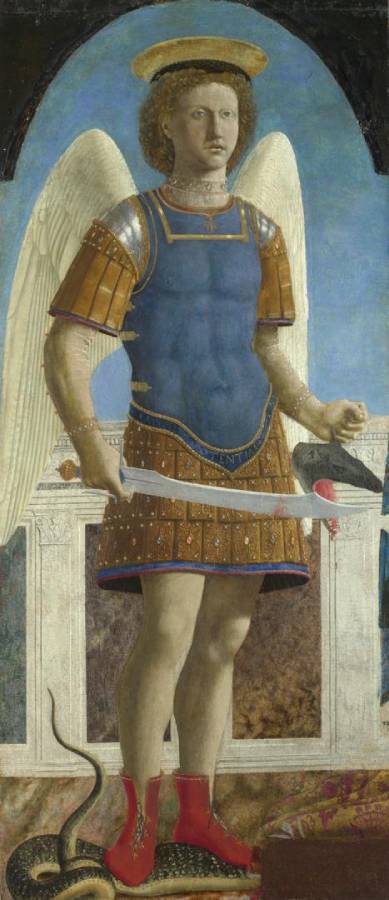Piero della Francesca (c.1416-1492)
San Michele Arcangelo (Saint Michael the Archangel)
completed 1469
Oil on poplar, 133 x 59.5 cm
National Gallery, London
The Archangel Michael led an army of angels to battle against the devil and cast him down from heaven (Revelation 12: 9). Piero shows him as a beautiful, youthful soldier, dressed in Roman armour, embellished with gemstones. Golden curls frame his smooth pale skin and full lips. His strength and courage are proved by his grim accessory – the severed head of the devil, represented as a snake with pointy ears and a full set of fangs. The kill is fresh: the reptilian head seems to still be screaming in anguish, blood dripping from its mouth; Michael pins the body down with his foot as its tail continues to rattle.
Michael’s pale wings match his skin. A cool light washes over him, casting the left side of his legs and face in shadow. His pose, where most of his weight is on his left foot and his body sways gently in the opposite direction, is called contrapposto; it was adopted by Renaissance artists who were copying the graceful style of Classical sculptures. The definition of the muscles of his chest and abdomen beneath his breastplate also recalls the idealised bodies of ancient nude male sculpture. His skin is notably pale and – perhaps to stress this visual connection with sculpture – Piero has made no attempt to differentiate the archangel’s skin from that of the marble decorating the low wall behind him.
The panel was part of a polyptych made for the church of Sant‘ Agostino in Piero’s hometown of Borgo Sansepolcro. It was placed to the immediate left of the central panel, now lost, which depicted the Virgin and Child according to both sixteenth– and nineteenth-century descriptions. The lower right corner of the panel includes part of the step of the Virgin’s throne and part of her cloth of gold cloak. Michael was paired with Saint Augustine, who stood to his left (now in the Museu Nacional de Arte Antiga, Lisbon); to the right of the Virgin were Saint John the Evangelist (The Frick Collection, New York) and Saint Nicholas of Tolentino (Museo Poldi Pezzoli, Milan).
The archangel’s inclusion may be related to the name of the patron of the altarpiece, Angelo di Giovanni. Michael was very popular in Sansepolcro: the pilgrimage to Monte Sant’Angelo in southern Italy, 325 miles from Sansepolcro – where Michael was thought to have appeared miraculously – was the most popular pilgrimage among the citizens of the town.
Piero was in great demand when he was commissioned to make this picture which may explain why, even though he signed the contract to make it in 1454, it was not completed until 1469. (NG)
See also:
• Sansepolcro (Italia)
